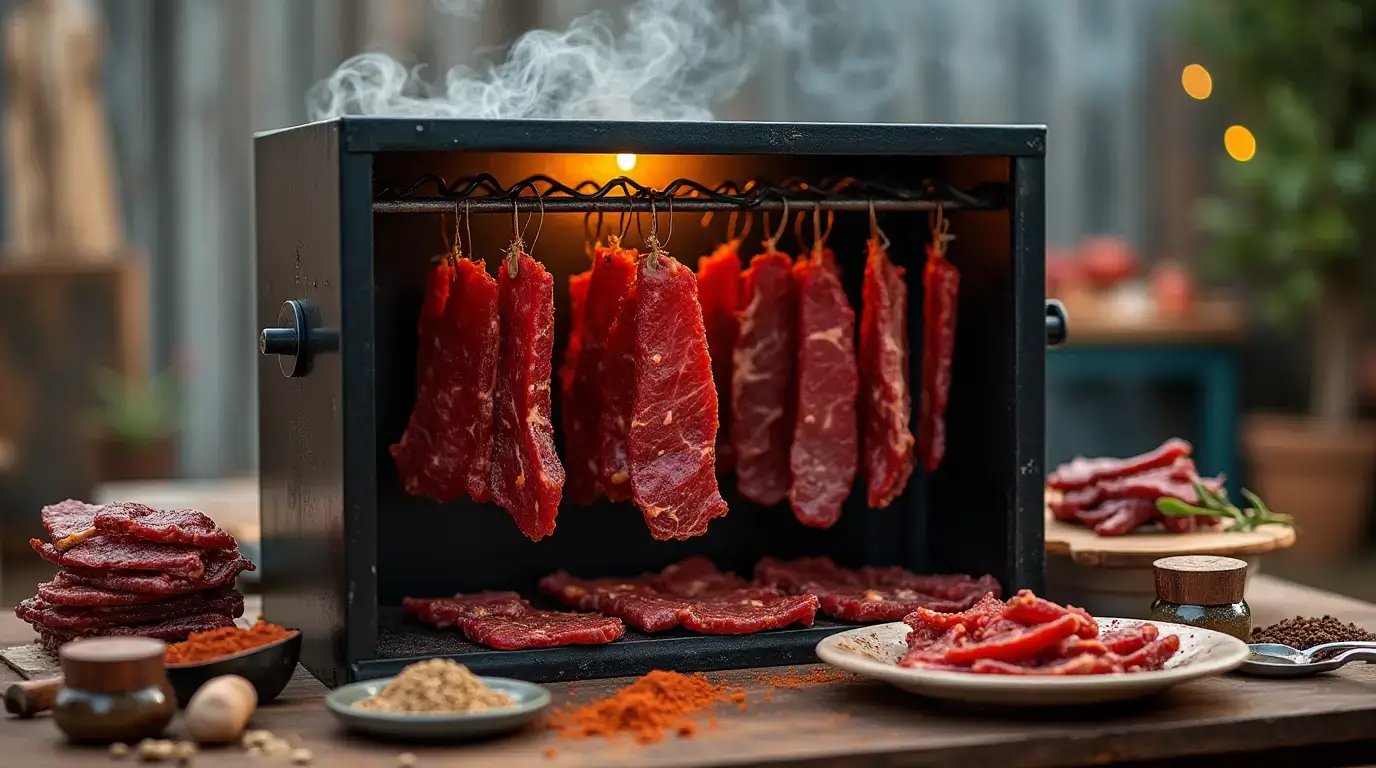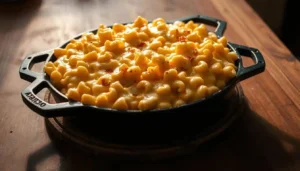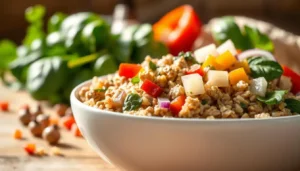Ultimate Guide: How to Make Beef Jerky in a Smoker with Easy Steps
Table of Contents
Have you ever bitten into homemade Beef Jerky Recipe and felt the crunch and smoky flavor? It’s a moment that takes you back to campfires, sharing stories and laughter. Making this snack is more than a recipe; it’s about making memories and bringing people together.
With a beef jerky recipe smoker, you can share your homemade smoked jerky with loved ones. This easy jerky recipe will show you how to pick the right ingredients and smoke it perfectly. Get ready for a culinary adventure that ends with a delicious reward!
Key Takeaways
- Ideal thickness for jerky slices is between ¼ to ⅛ inch.
- Marinate the beef for at least 12 hours, ideally 18-24 hours, for enhanced flavor.
- Smoking temperatures should be maintained between 150 to 180 degrees Fahrenheit.
- The average smoking duration is 2 to 2.5 hours to achieve the best texture.
- A batch of this jerky recipe typically yields about 40 servings.
- Storage in the refrigerator lasts a few weeks, while the freezer can preserve it for several months.
- Curing salt can be an optional addition to enhance preservation and flavor.
Understanding the Basics of Beef Jerky Recipe
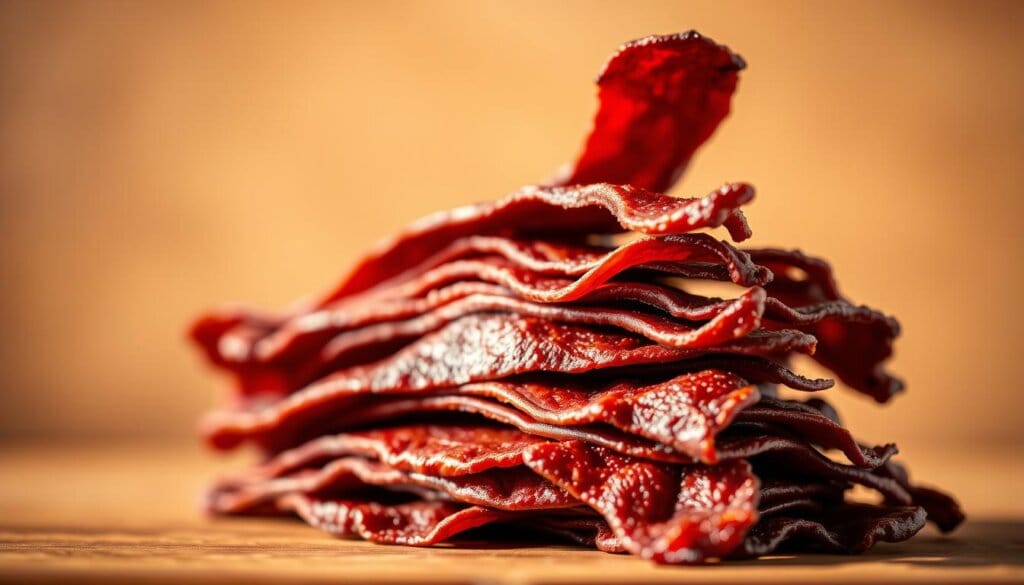
Beef jerky has won the hearts of snack lovers for many years. It’s a mix of great taste and easy to carry, loved by both outdoor fans and everyday snackers. Making beef jerky is a skill that shows off culinary talent and has a long history.
What is Beef Jerky?
Beef jerky is meat that’s been cured, seasoned, and dried. This makes it a chewy snack full of protein and flavor. It’s usually made from lean beef, ensuring it’s tasty and healthy.
History of Beef Jerky
The story of beef jerky is both interesting and varied, going back to ancient times. Early cultures dried meat to keep it fresh. The Inca people, for example, used salt and air to cure meat, starting the jerky tradition. Over time, the ways to preserve meat changed, but the core of beef jerky stayed the same. Now, it’s loved for its taste and health benefits.
Nutritional Benefits
Beef jerky is tasty and good for you too. It’s high in protein, giving you energy for active days. It’s also low in fat, making it a smart snack choice. Plus, it has important vitamins and minerals. But, some types can be high in sodium, so eat it in moderation.
| Nutrient | Amount per Serving |
|---|---|
| Total Calories | 1270 kcal |
| Protein | 206 g |
| Total Fat | 43 g |
| Saturated Fat | 15 g |
| Cholesterol | 572 mg |
| Sodium | 517 mg |
| Iron | 19 mg |
Choosing the Right Cuts of Beef
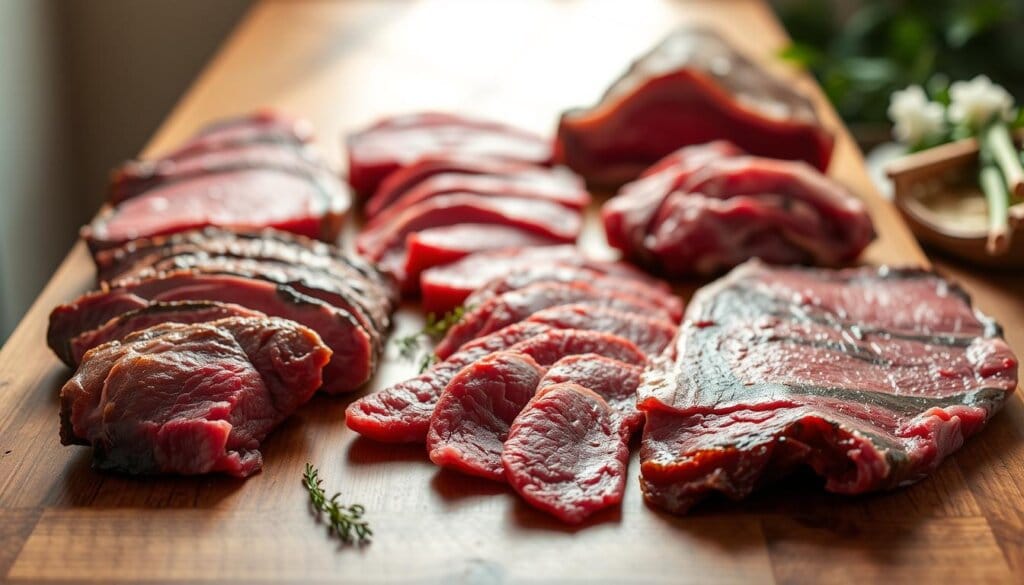
Choosing the right cut of beef is key to making great beef jerky. Leaner cuts are best for their texture and flavor. They also help avoid spoilage during drying. Here, you’ll learn about the top cuts for jerky and what to consider for your next project.
Top Cuts for Jerky
For the best taste and tenderness, pick these top cuts:
- Eye of Round: The most tender cut, perfect for jerky.
- Sirloin Tip Roast: A bit less tender but very popular.
- Top Round: Loved by experts, it’s flavorful and affordable.
- Bottom Round: Cheap and full of beef flavor, but tougher.
- Flank Steak: Has long muscle grains; slice against the grain for the best texture.
Factors to Consider
Several things affect your choice of cuts for beef jerky:
- Fat Content: Lean cuts prevent spoilage; too much fat can cause it to degrade quickly.
- Price: Cuts like top round and bottom round are cheaper, making them great for home use.
- Toughness: Cuts like bottom round may need longer marination or prep to be tender.
Recommended Marinades
A good marinade can make your beef jerky much better. Mix soy sauce, Worcestershire sauce, and spices for a strong flavor. Adding other ingredients can make it even more personal. The right marinade boosts flavor and tenderness.
Preparing the Beef for Jerky
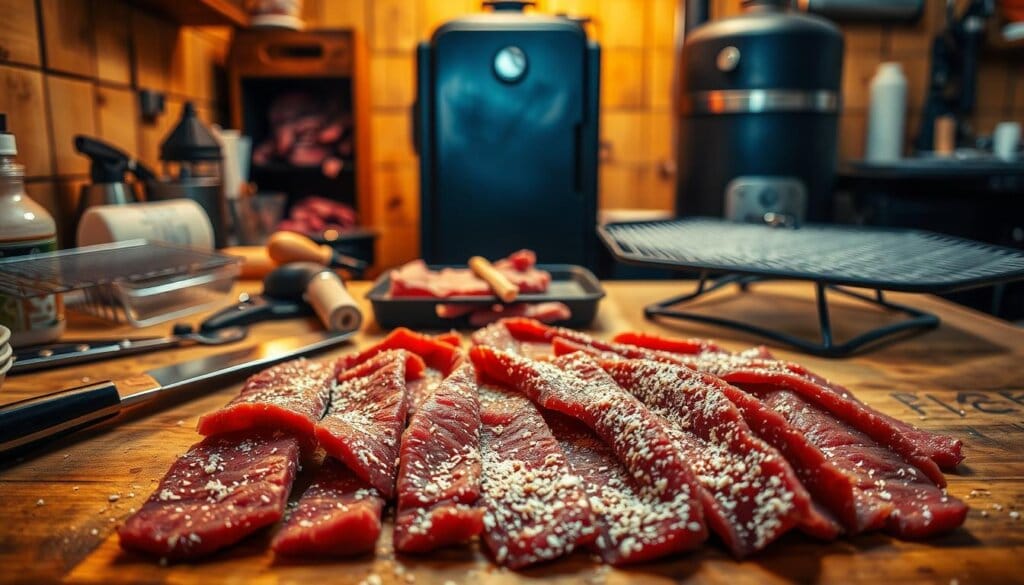
Getting your beef ready is key to making tasty beef jerky. Choose a good cut to start with. Trimming the beef is important to remove excess fat, which helps prevent spoilage. Also, make sure your slices are even, as this affects how the jerky dries and tastes.
Trimming and Slicing Techniques
The eye of round roast is a top choice for jerky because it’s lean and affordable. When trimming, remove all visible fat to keep the jerky fresh longer. Then, slice the meat to about 1/8 to 1/4 inch thick. This thickness helps it dry evenly and stay tender.
Freezing the meat for 1 to 2 hours before slicing can make cutting easier.
Importance of Uniformity
Having uniform slices is critical for consistent results. If slices vary in thickness, some might not dry right, leading to chewiness or spoilage. Sticking to the recommended thickness ensures a better product.
Tips for Slicing
Always slice against the grain for tender jerky. Use a sharp knife for precise cuts. A sharp knife also reduces the chance of tearing the meat. These tips will improve your jerky’s quality and make it more enjoyable to eat.
Essential Equipment for Smoking Jerky
Smoking jerky needs special equipment for the best taste and texture. Knowing the tools and their uses is key. The right essential equipment for jerky makes your snacks better.
Types of Smokers
Choosing a smoker for jerky is important. Here are some options:
- Electric Smokers: Simple to use with exact temperature control.
- Pellet Smokers: Great for flavor and versatile for other smoker recipes.
- Charcoal Smokers: Give traditional smoky taste but need more watching.
Recommended Accessories
Some accessories can improve your smoking experience:
- Racks: Help meat dry evenly by letting air flow.
- Wood Chips: Hickory or apple wood for the best flavor.
- Drip Pans: Catch grease and drips for easy clean-up.
Temperature Control Tools
Keeping the temperature right is key for jerky. Good tools help a lot. Aim for 160-180°F for drying. A digital thermometer helps keep the temperature steady.
Crafting Your Jerky Marinade
The marinade you choose can make a big difference in your beef jerky’s flavor. Classic recipes often use soy sauce and Worcestershire sauce for a savory taste. You can also try bourbon or spices for a unique flavor.
Trying out different flavors can make your jerky stand out. It will be something to remember.
Classic Marinade Recipes
A basic jerky marinade is easy yet effective. Here’s a simple recipe using flank steak:
- 2 lbs Flank steak
- 3/4 cup Soy sauce
- 3/4 cup Worcestershire sauce
- 1 tablespoon Honey
- 1 tablespoon Garlic powder
- Generous amounts of Salt and Pepper
Marinate the meat for at least four hours. An overnight soak is even better for flavor. Smoke at 120°F for three hours to get the perfect texture.
Unique Flavor Combinations
To make your jerky unique, try new flavor combinations. Use crushed red pepper flakes for spice or paprika for smokiness. Your creativity can lead to amazing discoveries:
- ½ cup Soy sauce
- ¼ cup Worcestershire sauce
- 2 tablespoons Honey
- 1 teaspoon Paprika
- 1 teaspoon Black pepper
Incorporating Spices and Herbs
Spices and herbs can boost taste and help preserve your jerky. Rosemary, thyme, and cayenne pepper add complexity. Use them wisely and adjust to your liking. A good marinade can turn your snack into a gourmet treat.
Smoking Techniques for Perfect Jerky
Making delicious beef jerky requires mastering certain smoking techniques. It starts with setting up the smoker right. Knowing the best smoking temperatures and times is key for great results. This ensures the jerky stays moist and tender.
Setting Up the Smoker
Before you start, make sure your smoker is clean and ready. Heat it up to the right temperature, between 150°F and 170°F. This slow heat helps remove moisture and adds flavor without burning.
Soak wood chips in water for 10-15 minutes before adding them. Choose types like oak, hickory, or pecan for the best taste.
Ideal Smoking Temperatures
Keeping the smoker at the right temperature is very important. The best temperature for jerky is about 200°F. This prevents charring. Every smoker is different, so watch it closely.
If you have a pellet smoker, expect to smoke for 3 to 5 hours. Traditional or electric smokers might take 6 to 8 hours.
Timing for Optimal Results
Timing is key for the best jerky. Smoking can take 3 to 10 hours, depending on the thickness and moisture. Aim for strips that are 1/8 inch to 1/4 inch thick.
Check the jerky every hour after three hours. Let it cool for 5 to 10 minutes before tasting. This makes sure it’s juicy but firm.
| Smoker Type | Average Smoking Time | Ideal Smoking Temperature |
|---|---|---|
| Pellet Smoker | 3 – 5 hours | 200°F |
| Masterbuilt Electric Smoker | 6 – 8 hours | 200°F |
| Traditional Smoker | 5 – 10 hours | 180°F – 200°F |
Monitoring the Drying Process
Creating great beef jerky needs careful drying process monitoring. This ensures the right texture and flavor. Knowing the signs of properly dried jerky helps avoid bad results.
Signs of Properly Dried Jerky
Check your jerky for a firm but flexible feel. It should bend easily, showing it’s dried right. It should also have a nice, dark color, not a dull gray.
Checking with a Thermometer
Using a thermometer is key to check the jerky’s internal temperature. Aim for 160°F for safety and flavor. A thermometer helps you hit this mark, making your jerky safe and tasty.
Avoiding Over-Drying
Take jerky off the heat just before it gets too crispy. It dries more as it cools. If it dries too much, it becomes hard and unpleasant. Getting this right makes your jerky perfect.
Storing Your Finished Jerky
Storing your homemade beef jerky right is key to keeping it fresh. The right storage methods can make your jerky last longer. This way, you can enjoy it for more time, keeping its taste and texture just right. Here are some top ways to store your jerky.
Best Storage Methods
For storing beef jerky, try these:
- Airtight containers slow down spoilage by keeping out moisture and air.
- Vacuum sealing is great for keeping jerky fresh longer, best when stored in the fridge.
- Refrigeration can keep your jerky fresh for up to 6 months if it’s vacuum sealed.
- Keep jerky in a cool, dry spot away from sunlight for long-term freshness.
- Adding a desiccant pack to the container helps keep moisture away, keeping the jerky quality up.
Shelf Life of Beef Jerky
Knowing the shelf life of beef jerky helps you enjoy it at its best:
| Storage Method | Shelf Life |
|---|---|
| Airtight packaging at room temperature | 1-2 months |
| Refrigerated vacuum-sealed jerky | Up to 6 months |
| Vacuum-sealed in freezer | Up to 1 year |
| Regularly checked jerky in pantry | 1 week |
Vacuum Sealing Tips
Vacuum sealing is the best way to keep your jerky fresh longer. Here are some tips for great results:
- Make sure the jerky is cool before sealing to avoid moisture buildup.
- Use top-quality vacuum bags to reduce air exposure.
- Mark your packages with the date to track freshness.
- After opening, vacuum-sealed jerky should be eaten within 3-5 days for the best taste.
Common Mistakes to Avoid When Making Jerky
Making homemade jerky can be very rewarding. But, it’s key to know the common mistakes that can spoil your effort. By avoiding these mistakes, you can make your jerky taste better and be of higher quality. Let’s look at three main areas where many people go wrong.
Underestimating Slicing
Slicing the meat right is a critical step in making jerky. If you slice it too thin, your jerky might not dry evenly. It could be too chewy in some parts and too dry in others. You should slice the meat to be between 1/8 to 1/4 inch thick. This ensures that your jerky dries evenly, making it taste better.
Ignoring Marinade Time
Not giving enough time for the meat to marinate is another mistake. The marinade needs time to soak into the meat, making it taste better. You should marinate the meat for at least 4 to 12 hours, depending on the recipe. If you rush this step, your jerky might not taste good.
Overlooking Temperature Settings
When drying the jerky, keeping the temperature right is very important. If you don’t, your jerky might not be safe to eat. It should dry at a low temperature, between 160°F to 180°F (71-82°C). This ensures it’s safe and has the right texture. By avoiding these mistakes, you can make jerky at home that’s as good as store-bought.
FAQ
What type of meat is best for making beef jerky?
How long does it take to smoke beef jerky?
What should I include in my jerky marinade?
How do I prevent my beef jerky from spoiling?
What temperature should I smoke my jerky at?
How can I tell if my jerky is done drying?
Can I use any type of smoker for making jerky?
What are common mistakes to avoid when making beef jerky?
Is homemade beef jerky healthier than store-bought options?
Enjoyed the recipe? We’d love to hear your thoughts! Leave a review and share your feedback in the comments – your input helps us bring you even more delicious dishes!
There are no reviews yet. Be the first one to write one.

